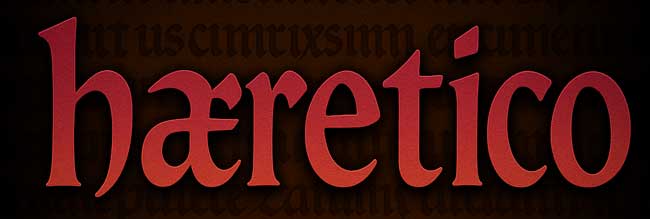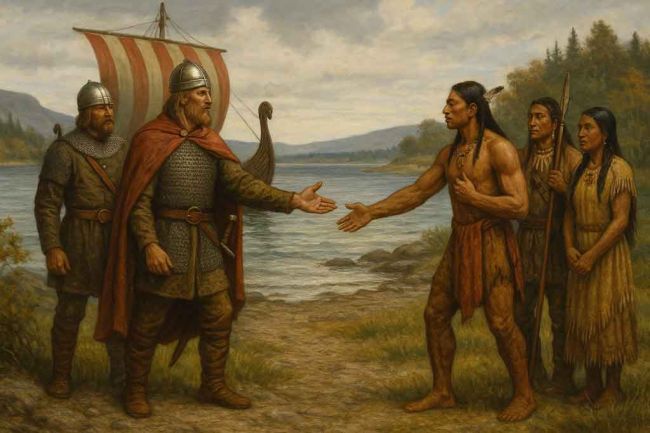Written by David Caldwell ·
Who Discovered America? Did Columbus Learn of Vinland on His Visit to Iceland?
The Victorian Case for Leif Erikson over Columbus
In 1891, the German-born writer Karl Blind, contributing to The Bookseller, declared that “for anyone conversant with the course of Norse history, there cannot be the slightest doubt” that the Icelanders, not Christopher Columbus, were the first Europeans to discover and explore parts of North America.
Blind’s statement came as the United States was preparing vast celebrations for the four hundredth anniversary of Columbus’s first voyage in 1492. These festivities, he noted, had been set in motion “for the celebration of the four hundredth anniversary of the sailing of the Genoese, who, according to recent research, may possibly have been a Corsican by birth.” Even Columbus’s origins, he pointed out, remained “to this day, rather obscure.”
Other Victorian commentators saw more than historical commemoration in the air. An editorial in the Bookseller suggested the Columbus celebrations were “nothing more than a gigantic scheme for drawing the trade of Central and South America into the United States.” The claim that Columbus “discovered America” was, to some Victorians, a relatively recent American invention, one that conveniently ignored the indigenous civilisations of both continents and the earlier voyages of other explorers.
Before Columbus - Ancient and Medieval Theories
Victorian journalists also reminded readers that theories of trans-oceanic contact predated the Viking sagas.
Some speculative accounts spoke of Buddhist monks who, “many centuries before the time of Columbus,” may have drifted eastward from Asia and reached “a great country beyond the sea,” carried by prevailing currents.
In Christian legend, Saint Brendan the Navigator, “the bold monk of Ireland”, was said to have sailed west into the Atlantic, reaching a Promised Land of the Saints, a fertile paradise across the water. Recorded in medieval hagiographies and sung in Latin verse, Brendan’s voyage is generally seen today as allegorical, yet in the Victorian age such tales were still taken by some as hints of pre-Columbian European contact.
The Norsemen and the Sagas
It was the Norse voyages, however, that Victorians regarded as the most credible pre-Columbian European presence in America. The Western Morning News (22 October 1890), reporting on the Congress of Americanists in Paris, stated that “towards the year 1000 Leif Erikson discovered what are now the New England States,” and that his “memory is not stained like that of the Spanish Admiral.”
The Norse route west began with the colonisation of Iceland in the ninth century, followed by Greenland in the late tenth.
From there, “nearly nine hundred years ago” the Norse reached Newfoundland, the north point of the Labrador Peninsula, Nova Scotia, and Massachusetts. They established settlements and maintained contact for resources such as fur and timber. Some chroniclers believed that by the fourteenth century they had reconnoitred “along the coasts of Maine and New York, perhaps even as far south as Maryland.”
The Saga Voyages
The sagas credit the first sighting of America not to Leif but to Bjarni Herjolfsson, around 986 AD. Sailing from Iceland to Greenland, he was blown off course in fog and glimpsed an unknown shore but did not land.
Leif Erikson, hearing of Bjarni’s sighting, purchased his ship and set out with 35 men, including a German from Bremen named Tyrker. They made landfall first at Helluland (“Flatstone Land”, probably Labrador), then at Markland (“Woodland”, perhaps Newfoundland), and finally at a fertile region where Tyrker discovered vines and wild grapes, prompting the name Vinland.
The German chronicler Adam of Bremen mentioned Vinland as early as 1072, describing it as a place where “the self-sown vine grows.”
Leif’s brother Thorvald led a second expedition with 30 men but clashed with natives , identified in the sagas as Skrælings, near Keel Cape (Cape Cod). Thorvald was killed by an arrow. Another brother, Thorstein, attempted the voyage but died en route.
Thorstein’s widow, Gudrid, remarried the nobleman Thorfinn Karlsefni, persuading him to mount a large-scale voyage of 150 men. Their son Snorre, born in Vinland, became the ancestor of Snorri Sturluson, the Icelandic historian who authored Heimskringla and parts of the Younger Edda. Icelandic genealogies meticulously recorded these descents, allowing nineteenth-century figures like Thorlacius, Finn Magnússon, and the sculptor Thorvaldsen to trace their lineage to Snorre.
Encounters and Archaeology
The Skrælings were described as “wild men”, sometimes short in stature, like modern Inuit, or inhabiting only sparsely populated territories. Blind noted that skeletons found in the north-east of America showed “a primitive Eskimo race there.”
While these accounts were long doubted, archaeological discoveries such as the Norse settlement at L’Anse aux Meadows have since confirmed a Viking presence in North America around the year 1000.
Columbus and the Norse Legacy
Karl Blind also made a pointed observation: in 1477, Columbus himself had visited Iceland, where he “held conversations, in Latin, with Bishop Magnus of Skalholt.” Could he have failed to hear of Vinland and the sagas? “Most certainly not,” Blind wrote.
Columbus’s voyages never brought him to mainland North America. Instead, his landfalls were in the Bahamas, Hispaniola, and later in parts of Central and South America. His legacy was bound up with the expansion of Spanish power in the Caribbean and Latin America, not with discovery of the lands that became the United States.
Cabot and the Honour of Rediscovery
The Bookseller reminded readers that “the honour of the rediscovery of the North American continent belongs to the English Expedition of 1497 under the command of Cabot.” Sailing from Bristol, John Cabot reached either Newfoundland or Cape Breton, and from his voyage “all our English claims in the New World were derived.”
By contrast, Columbus “never once saw the mainland of North America.” To Victorians, the American choice of Columbus as symbolic “discoverer” looked less like historical fidelity and more like political branding.
Statues, Politics, and Victorian Scepticism
By 1891, recognition of Leif Erikson was slowly growing, “a statue has… been recently raised to him in Boston,” Blind noted, but such gestures were dwarfed by the Columbus commemorations. The Western Morning News argued it “would be far better if the United States of America… were rather to celebrate the deed of Leif Erikson” than that of Columbus.
For many Victorian writers, the motive was clear. As one critic in The Bookseller put it, “regard for historical truth has nothing in the world to do with it.” The anniversary was “nothing more than a gigantic project” to extend American trade dominance into Central and South America.
Karl Blind’s following assessment strikes modern readers as unexpectedly humane for a nineteenth-century commentator. “The truth of the earlier discovery is now held,” he wrote, “but curiously kept in the background, perhaps because, instead of bringing over a continent, attended or trafficked in human beings, the discoverers treated the natives as men and objects of inspiration.” By Victorian standards, and certainly by the brutal norms of colonial conquest, this was a remarkably “progressive” framing. It implicitly acknowledged that the Norse encounter with America, whatever its frictions, did not unfold as the vast systems of enslavement, dispossession, and mass death that followed the Spanish conquests.
Yet Blind’s phrasing still framed “discovery” from a European perspective, as if the Americas were somehow unknown until charted by outsiders. In reality, both continents were already home to millions, with civilisations of extraordinary sophistication, from the city-states of the Maya and the Aztec empire to the mound-building cultures of the Mississippi and the Inuit societies of the Arctic. What was “discovered” in 1000 or 1492 was, in truth, contact between worlds, seen here through the eyes of Europeans and their descendants.
The Victorian Verdict
By the closing years of the nineteenth century, the British press’s alternative narrative was firmly in place:
- The Norse reached America five centuries before Columbus, establishing contact and attempting settlement.
- Cabot, not Columbus, brought North America back into Europe’s charts during the Age of Exploration.
- Columbus’s fame in the United States was as much political construction as historical fact.
In the words of Karl Blind, America , “on whose territory Columbus never set foot”, would do better to celebrate the Icelander who “towards the year 1000 discovered what are now the New England States; and whose memory is not tainted like that of the Spanish Admiral.”
Sources:
- Karl Blind, “The Americanists in Paris. The Pre-Columbian Norse Discovery of America,” The Bookseller, Thursday 5 March 1891.
- Western Morning News, Wednesday 22 October 1890.
- Unnamed editorial, The Bookseller, Thursday 5 March 1891.
Related Articles
4 October 2025
The Ancient Blood: A History of the Vampire27 September 2025
Epona: The Horse Goddess in Britain and Beyond26 September 2025
Witchcraft is Priestcraft: Jane Wenham and the End of England’s Witches20 September 2025
The Origins of Easter: From Ishtar and Passover to Eggs and the Bunny12 September 2025
Saint Cuthbert: Life, Death & Legacy of Lindisfarne’s Saint7 September 2025
The Search for the Ark of the Covenant: From Egypt to Ethiopia5 September 2025
The Search for Camelot: Legend, Theories, and Evidence1 September 2025
The Hell Hound Legends of Britain25 August 2025
The Lore of the Unicorn - A Definitive Guide23 August 2025
Saint Edmund: King, Martyr, and the Making of a Cult14 August 2025
The Great Serpent of Sea and Lake11 August 2025
The Dog Days of Summer - meanings and origins24 June 2025
The Evolution of Guardian Angels19 June 2025
Dumnonia The Sea Kingdom of the West17 June 2025
The Roman Calendar, Timekeeping in Ancient Rome14 June 2025
Are There Only Male Angels?
